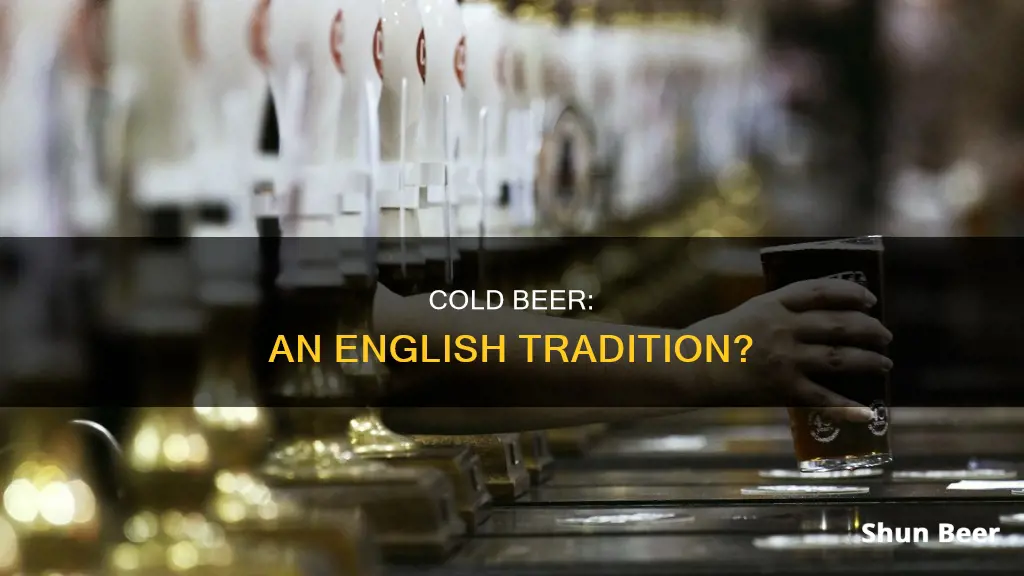
Do people in England drink beer cold? It's a question that has been asked by many travellers to the country, and the answer is not as straightforward as one might think. While it is true that British people do not typically drink their beer warm, as some rumours may suggest, there is a preference for drinking beer at a cooler temperature than what might be considered ice-cold in other parts of the world.
The myth that Brits drink warm beer is believed to have originated during World War II when American GIs stationed in the UK found that the local cask beer was not served chilled like the lager they were used to back home. This cultural difference led to the teasing notion that Brits drank their beer warm, which then passed into popular belief, despite not being entirely accurate.
In reality, cask beer in the UK is typically served at a cool temperature, ranging from 10-13°C for ales and around 14-15°C for stouts. This temperature is often referred to as cellar temperature and is meant to bring out the richness and complexity of the beer without numbing the drinker's taste buds. While some pubs may serve beer at higher temperatures, it is rare to find beer served warm or at room temperature.
When it comes to lager, which has become increasingly popular in the UK, it is typically served colder than ale but still not ice-cold. A good-quality pilsner, for example, is best served between 7-10°C to allow the hop aromas and delicate flavours to be fully appreciated. Serving lager too cold can hide any unpleasant aftertastes, which is why some mega-brewers push for their products to be served extra cold.
So, while people in England may not drink their beer ice-cold, they certainly don't drink it warm either. The preference is for a cooler temperature that strikes a balance between refreshment and flavour, allowing drinkers to fully enjoy the nuances of their chosen brew.
| Characteristics | Values |
|---|---|
| Do people in England drink beer cold? | Beer in England is not served warm, but at cellar temperature, which is around 10-13°C for ales and 14-15°C for stouts. Lager is served colder than ale, at 7-10°C. |
What You'll Learn

The myth of English people drinking warm beer
It is a common misconception that people in England drink warm beer. This myth likely originated during World War II when American GIs stationed in Britain were served cask beer, which is typically served at cellar temperature, and not the ice-cold lager they were used to back home. The GIs' tales of the Brits drinking warm beer were likely meant as a joke, but the humour was lost in translation, and the myth was born.
It is true that cask beer is not served ice-cold, but it is also not served at room temperature. The recommended serving temperature for cask beer is between 10-13°C (14-15°C for stouts), which is cool and refreshing and allows the richness and complexity of the beer to shine through. Serving beer too warm or too cold can undermine the drinking experience by muting or disguising the flavours.
While it is rare to find beer served at room temperature in England, it is also not difficult to find cold beer. Lager, which is typically served colder than ale, is widely available and often served refrigerated. Even some ales, such as Boddingtons, are chilled. So, if you're travelling to England and prefer your beer cold, fear not—you won't go thirsty!
A history of the myth
The idea that English people drink warm beer is a misconception that likely began during World War II. American GIs stationed in Britain found that the local beer, cask beer, was served at a different temperature than the ice-cold lager they were used to back home. The GIs' tales of drinking warm beer were likely meant as a joke, but when these stories reached the States, the humour was lost in translation, and the myth was born.
The truth about beer temperature in England
So, do English people drink their beer at room temperature? The short answer is no. Cask beer, which includes ales and stouts, is typically served at cellar temperature, which is cooler than room temperature. The recommended serving temperature for cask beer is between 10-13°C (14-15°C for stouts). This temperature is cool and refreshing and allows the flavours of the beer to come through. Serving beer too warm or too cold can mute or disguise the flavours, undermining the drinking experience.
While it is rare to find beer served at room temperature in England, it is also not difficult to find cold beer. Lager, which is typically served colder than ale, is widely available and often served refrigerated. Even some ales, such as Boddingtons, are chilled. So, if you're travelling to England and prefer your beer cold, you won't have to look far!
The importance of temperature for different beer styles
Different styles of beer have different optimal serving temperatures. For example, a good-quality pilsner should be served between 7-10°C to allow the hop aromas and delicate malt and citrus flavours to perform at their peak. Serving lager too cold can make it more immediately refreshing but can also disguise unpleasant aftertastes, which may be why mega-brewers often serve their lager ice-cold. On the other hand, serving lager too warm can make it taste bland and flavourless.
Cask beer, on the other hand, should never be served ice-cold. When served at the correct temperature, the richness and complexity of cask beer come to the fore. However, if served too warm, the beer can become unpleasant. This is why it is essential to store and serve cask beer at the correct temperature—not too warm, not too cold, but just right!
Drinking Alcohol-Free Beer: Is It Safe to Drive?
You may want to see also

The optimal temperature for drinking beer
A Historical Perspective
It is a common misconception that people in England drink beer warm. This myth likely originated during World War II when American GIs, used to crisp cold lager, found the local cask beer less chilly. However, this does not mean that the English drink their beer warm. In fact, the optimal temperature for drinking beer depends on the type of beer and can enhance its flavour profile.
Cask Beer and Ale
Cask beer is typically served at cellar temperature, which is around 10-13°C for optimal flavour. Serving it too warm can negatively impact the drinking experience. Casque Marque, a group that monitors cask ale temperature, found in a 2005 survey that 44% of 2,000 pints exceeded the optimal drinking temperature, but none were considered "warm".
Ale is best enjoyed slightly chilled, as this temperature allows the richness and complexity of the beer to shine through. Serving ale ice-cold can numb your taste buds and make it difficult to appreciate its flavours.
Lager
Lager is typically served colder than ale, but it should not be so cold that you can't taste its flavour. A good-quality pilsner is best served between 7-10°C to highlight its hop aromas and delicate malt and citrus flavours. Mega-brewers often serve lager extra cold to disguise any lack of flavour or unpleasant aftertastes.
Stouts
Stouts, such as Guinness, are typically served slightly cooler than ale, with an optimal temperature range of 14-15°C. Some pubs may offer extra-chilled stouts for those who prefer their beer colder.
Personal Preference
Ultimately, the optimal temperature for drinking beer comes down to personal preference. While serving temperatures can enhance the flavour of a beer, some may prefer their beer colder or warmer than the recommended range. Additionally, the ambient temperature can also influence how refreshing a beer feels. For example, during hot summer days, a colder beer may be more appealing.
Beer and Boosters: What's Safe to Drink?
You may want to see also

The difference between ale and lager
Ales and lagers are the two main categories of beer. While there is a lot of variety within these categories, the difference between them lies in the yeast used and the fermentation technique.
Ales are fermented with Saccharomyces cerevisiae, or ale yeast, at warm temperatures (60–78°F). Ale yeast is often referred to as "top-fermenting" because the most obvious fermentation activity appears to occur on the surface of the beer, though this term may also refer to the tendency of ale yeast to flocculate (form clumps) at the surface before precipitating to the bottom of the fermenter. Lager, on the other hand, is fermented with Saccharomyces pastorianus, a "bottom-fermenting" yeast, at cold temperatures (35˚–58˚F).
The difference in fermentation temperature influences the flavour of the beer. Ales can generally ferment and age relatively quickly (3-5 weeks) because of their warm fermentation, while lagers take longer (up to 6-8 weeks). The colder fermentation temperature of lagers means that yeast-derived flavours like esters and phenols are rarely present. Ales, on the other hand, can have complex esters and phenols added to the beer as the fermentation temperature increases, creating interesting complexities in the flavour.
The birth of the Pilsner style in the 1800s introduced much of the world to lagers, but before then, almost all beer was ale since yeast was not known as an ingredient and cold fermentation would have been difficult. Today, ales are typically more common among craft brewers because ale yeast can produce beer more quickly, which is more convenient for small breweries.
Beer Overdose: Can Drinking Beer Kill You?
You may want to see also

The history of beer in England
Ancient Times to the Middle Ages
Beer brewing in England has a long history, possibly dating back to the arrival of the Romans in 54 BC. In the 1980s, archaeologists found evidence that Roman soldiers in Britain sustained themselves on Celtic ale. Brewing was likely well-established by the time the Romans arrived and continued to flourish under their rule. The earliest named brewer in British history was Atrectus the brewer, mentioned in Roman accounts from around AD90-AD130.
During the Middle Ages, beer was a common drink, consumed daily by all social classes in northern and eastern Europe, where grape cultivation was difficult. In England, per capita consumption was 275-300 liters per year by the Late Middle Ages, and beer was drunk with every meal. Alewives would brew beer and put out an ale-wand to signal when it was ready. Men eventually became involved in brewing, forming guilds like the Brewers Guild in London. As brewing became more organised, many inns and taverns began buying beer from these early commercial breweries rather than brewing their own.
1400s to 1700s
The use of hops in beer was introduced to England from the Netherlands around 1400, with the earliest mention of beer being brewed in England (from imported hops) in Colchester in 1412. Hops were being planted in England by 1428, and cultivation began around 1520. This new ingredient added bitterness and helped preserve the beer. Ale drinking was not abandoned easily, and both ale and beer continued to be consumed as distinct beverages for some time.
1700s to 1800s
The 18th century saw the development of popular new styles like porter, the first beer to be aged at the brewery and dispatched ready to drink. Porter brewers in London, such as Whitbread and Truman, achieved great financial success. This period also saw the emergence of India Pale Ale (IPA), which became popular in England and was exported to India. The Beerhouse Act of 1830 allowed anyone to brew and sell beer, leading to the opening of hundreds of new pubs and reducing the influence of large breweries.
1900s to World War I
In the early 1900s, serving draught beer from pressurised containers began, and artificial carbonation was introduced in 1936. The temperance movement of the late 19th and early 20th centuries, combined with World War I emergency measures, brought changes such as higher beer taxation, lower strengths, and restricted opening hours.
Post-World War I to 1999
Lager began to gain popularity in the mid-20th century, increasing from 2% of the market in 1965 to 20% in 1975. Home brewing was legalised in 1963 and became a popular hobby. The Campaign for Real Ale (CAMRA) was founded in 1971 to protect traditional, unpressurised beer and brewing methods. The group coined the term "`real ale`" to differentiate between cask ale and beer served under pressure.
2000s to Present
There has been a recent "explosion" of interest in craft beer, with a shift towards smaller breweries and more flavourful, distinctive beers. While the choice available to English beer drinkers is perhaps unparalleled, there are concerns about the future of pubs, with about 30 closing per week. However, craft beer outlets, the Wetherspoons chain, and the micropub movement are bucking this trend.
Kicking the Beer Habit: Strategies for Sobriety
You may want to see also

The effect of temperature on the taste of beer
The temperature at which beer is served can have a significant impact on its taste. While personal preference plays a role in how people enjoy their beer, the type of beer also dictates the ideal serving temperature.
Lager vs Ale
Lager and ale are two distinct styles of beer with different ideal serving temperatures. Lager, including mass-market pilsner-style beers, is generally served chilled, between 7°C and 10°C. This temperature range strikes a balance between refreshment and flavour perception. Chilling lager too much can mute its flavour, while serving it slightly warmer allows the hop aromas and delicate malt and citrus flavours to come through.
Ale, on the other hand, is traditionally served at "cellar temperature," which falls between 10°C and 13°C for most ales, and 14°C to 15°C for stouts. This temperature range is said to bring out the richness and complexity of the beer without numbing the taste buds, as ice-cold beer tends to do.
Cultural Preferences
The preference for drinking beer cold or warm varies across cultures. The "warm beer" myth associated with the UK is believed to have originated during World War II when American GIs, accustomed to crisp cold lager, encountered the less chilly cask beer popular in Britain at the time. However, even in the UK, where ale is traditionally served at cellar temperature, the preference for "extra cold" beer has gained traction, with some brands even releasing "extra cold" versions of their products.
Optimising the Beer-Drinking Experience
Ultimately, the ideal beer temperature depends on the type of beer and personal preference. Chilling beer too much can mute its flavour, while serving it too warm may make it taste unpleasant. Finding the right temperature enhances the drinking experience, allowing the nuances of the beer to shine through.
Breastfeeding and Beers: How Many Are Safe?
You may want to see also
Frequently asked questions
No, this is a myth. Beer in England is not warm, but it is also not ice cold. It is usually served at cellar temperature, which is around 10-13°C (14-15°C for stouts).
Drinking beer at this temperature allows the richness and complexity of the beer to come to the fore. It also does not numb your taste buds like ice-cold beer does.
Yes, lager is served cold in England, usually between 7-10°C.







